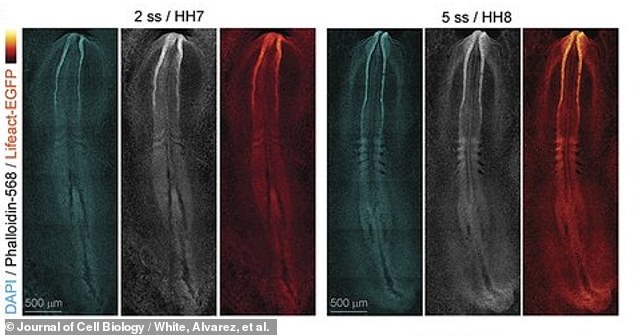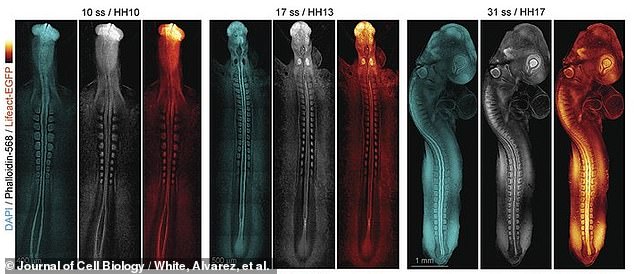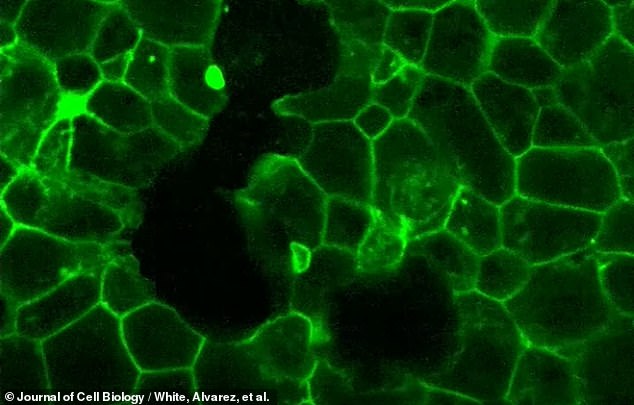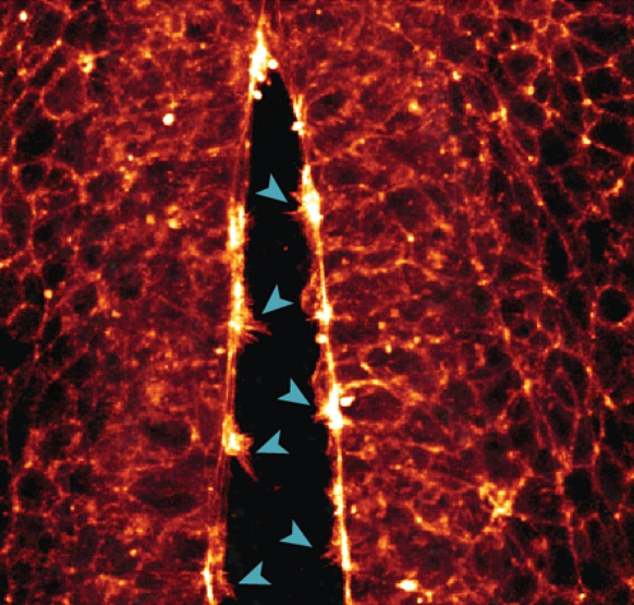Incredible first-of-its kind video of an embryo forming – which scientists hope will solve medical mysteries
Scientists have captured the first ever early stage of embryo formation, which could help solve the ‘mystery’ of how birth defects develop in humans.
Australian researchers watched in amazement as the cells of a quail embryo crawled around a protein-based support structure, organising themselves into the earliest form of the heart and the first stage of the spine and brain, the so-called ‘neural tube’.
An innovative technique using fluorescent proteins was used to illuminate the cells within the tiny embryo as the team recorded the embryo’s first moments taking shape.
Because the quail embryo is very similar to the human type in these early stages, researchers now want to study in real time which early errors of these embryonic cells lead to birth defects. This way they can improve future treatments for humans.
For the first time ever, scientists have recorded real-time video of an early-stage embryo forming the ‘neural tube’ that will grow into its brain and spinal cord (above). An innovative technique using fluorescent protein was used to illuminate this tiny embryo

The researchers – molecular bioscientists from the University of Queensland in Australia – report that these new videos could soon help modern medicine understand congenital birth defects and how to correct them. Above, stills of the embryo’s early spinal column and brain formation

Above, later photographs of the early spinal and brain formation of the embryo
According to the study’s lead author, about three percent of all human babies are born with birth defects, most commonly heart defects and neural tube defects.
The only available treatments are surgeries that take place just a few days after birth. In more severe cases, transplants are needed because of heart defects.
Scientists from the University of Queensland have created a genetically engineered quail embryo that developed and simultaneously produced a reflective fluorescent protein called Act of life.
The genes for the production of these Lifeact proteins were implanted into the living quail embryo via direct injection into the blood-circulating primordial germ cells.
‘Bird-like [meaning birds, like quail] “Embryos are an excellent model for human development,” says Dr. Melanie White, but especially in these early stages of growth.
“The development of many important organs, including the heart and the neural tube (which eventually becomes the brain and spinal cord), is much the same,” she said.
Quail embryos are also easier to observe alive as they grow, because the thin shell of an egg is easier to see through medical technology and can be left alone.
“It is very difficult to film these stages of embryonic development because they occur after human embryos have implanted in the mother’s womb,” Dr. White explains.
“Because quails grow in an egg, they are very accessible to imaging,” she noted, “and their early development is very similar to that of a human at the time the [human] embryo implants in the uterus.’

Above, the glow of the fluorescent proteins revealed the embryo’s early scaffolding, called the ‘actin cytoskeleton’, which gives cells shape and helps them move. The fluorescent proteins selectively bind to actin, also a protein, and give definition to this early embryonic structure
The glow of these fluorescent proteins revealed the embryo’s early protein scaffolding, the ‘actin cytoskeleton’, which gives cells a shape to cling to and helps them move.
These fluorescent proteins selectively bind to actin, which is also a protein, causing this early embryonic structure to light up and gain definition.
Using this illumination, the researchers were able to capture the formation of arm-like projections on individual cells (lamellipodia and filopodia). These projections help the cells to crawl along the protein carriers of the cytoskeleton to the right place.
Dr. White and her colleagues documented cardiac stem cells deep within the embryo as they climbed into place on the cytoskeleton to form the early heart.
“This is the first time anyone has captured live images of the cell’s actin cytoskeleton, which makes this contact possible,” Dr. White said in a rack.
“One of the key things we’re missing is the dynamic information about how the embryo coordinates the movement, positioning and fate of its cells to get from one stage to the next,” Dr. White explained the purpose of the new videos. Newsweek.
“This information can only be obtained using live imaging, which allows us to follow how the embryonic tissue changes over time,” she said.
“How cells interact with each other and organize into complex tissues in real time in the forming embryo is still largely a mystery,” said Dr. White.
One of the other crucial events captured by the Queensland team’s technique was the ‘zipping up’ of cells along the long open edges of the embryo’s neural tube.
Like a burrito or wrap, the cells fold into a tube-like shape and close in a zipper-like motion into a tube, while the lamellipodia and filopodia, which resemble little arms, connect to each other.
Once this newly formed neural tube is closed, it will continue to grow and mature into the form it will take in the future: the brain and spinal cord.
“We saw the cells extending their projections across the open neural tube to contact the other side,” Dr. White said.
‘The more protrusions the cells formed, the faster the tube collapsed.’

Above is an image of the ‘zipper’ movement, as the embryo’s ‘neural tube’ is formed by the arm-like extensions of each cell – the lamellipodia and filopodia – grasping each other

Above, the researchers were able to capture the formation of arm-like projections on individual cells, which help the cells crawl along the protein supports of the cytoskeleton to the right place. In the image above, the cell’s arms close the neural tube walls.
It is precisely this process, she said, that often “goes wrong or is disrupted” during the fourth week of human development — leading to birth defects of the brain or spine, whether inherited or caused by environmental factors.
“Our goal is to find proteins or genes that can be targeted in the future to screen for birth defects,” said Dr. White.
“We are very excited about the possibilities this new quail model now offers to study development in real time,” said the researcher, who also leads the Dynamics of Morphogenesis Lab at the Institute for Molecular Biosciences in Queensland.
The work of Dr. White and her team was published in June of this year in the journal of cell biology.
“In our lab, we are now building on the initial experiments we did to try to understand how the heart and neural tube form in real time,” she said.
Dr. White’s team is currently investigating “how mutations identified in patients or how factors occurring in the mother (diabetes, nutritional deficiencies) disrupt this development and lead to birth defects.”
